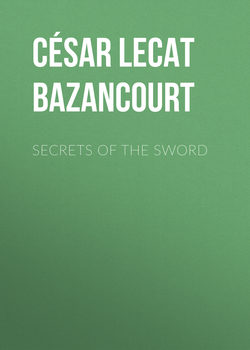Читать книгу Secrets of the Sword - César Lecat de Bazancourt - Страница 1
PREFACE
ОглавлениеIf French is, as we have been told, the natural language of the art of fencing, it seems a particularly rash venture to translate a French book on the subject into English. This is especially the case when the original is such a work as Les Secrets de l’Épée, which so far from being a dry technical manual, that might be sufficiently rendered by a baldly literal version, is one of those fascinating, chatty books, written in a happy vein, in which the manner of writing is the matter of principal importance. But the delightful ease and artful simplicity of style that captivate the reader are the translator’s despair. I have made the attempt for my own amusement, and I am publishing my translation because the original work, which was first published in 1862 and reprinted in 1875, has been for some years inaccessible, and because I think it is a book that will interest English fencers.
An interesting and appreciative account of the book is given in the introduction to the volume devoted to fencing in the Badminton Library, together with some criticism of the author. The would-be fencer is cautioned that the Baron de Bazancourt is ‘a very expert literary dodger’ whose specious arguments must be studied with the greatest caution. The warning note is no doubt wise in a book intended for the English fencer, for English fencing certainly shows no tendency to be excessively correct, but is rather inclined to err in the other direction. But no fencer who reads the work attentively can fail to derive from it a real profit, and, I hope, a real pleasure. The keynote of the book is that a fencer must fence with his ‘head.’ Bazancourt generally calls it ‘instinct,’ or ‘inspiration.’ But call it what you will, there can be no doubt that the continual tax that fencing makes on the resourcefulness of the player gives it its subtle and enduring charm. The unforeseen emergencies that have to be faced, and the varieties of play that are encountered in meeting different opponents, make fencing of all sports the least mechanical and the least monotonous.
We are often told that fencing will never be popular in England, because it is no longer required for practical purposes. But does anyone suppose that we are guided by practical considerations in choosing our sports? Fencing is a most exhilarating exercise and one that is particularly suitable for those of us who live a town life. A dull day in London may be very sensibly enlivened by a brisk assault. The luxury of getting into flannels is increased by the reflection that for an hour at any rate one will think of nothing but the foils. For no exercise is so absorbing as fencing. Whether you are taking a lesson or are engaged in a friendly combat your whole attention cannot fail to be occupied. There is room for nothing else, and on that account alone fencing must be commended as a mental relaxation of the highest value.
Compared with boxing, fencing has the advantage that it can be continued even into old age. Now, however willing one may be to be punched and pommelled, there usually comes a time when it is inconvenient to appear in public with a black eye or a bruised cheek. Few men who take to fencing and master the preliminary stages can make up their minds to give it up, until they are obliged to do so for want of time or opportunity.
The cosmopolitan character of fencing is another point in its favour. Not only throughout France and Italy, but wherever French or Italian is spoken, fencing rooms abound, and the stranger who visits them is sure to be received with friendly interest and hospitality. Fencers are always glad to try conclusions with a new blade, and a very moderate knowledge of the art may often serve as a pleasant and informal introduction in a strange country.
The art of translation is perhaps as slippery and elusive as the art of fence. L’escrime vit de loyales perfidies says the Baron de Bazancourt. He might have said the same thing of translation. I have endeavoured to give a faithful rendering of this book. It has equally been my object to make my version readable. I am conscious of many defects, and cannot hope to have avoided mistakes, but if I have sometimes been perfidious, I trust that I have never been disloyal.
I have to thank many friends for assistance and advice, and I am especially indebted to Mr F. H. Townsend for the spirited series of fencing drawings that accompany the text.
C. F. CLAY.
London,
October, 1900
